Recent Fire Damage Posts
Let's learn about FIRE
6/30/2023 (Permalink)
A fire can happen to anyone at anytime, but the Holiday season is peak season!
Winter is quickly approaching as well as the holiday season. This time of year automatically raises the chances of fire in our homes. Many of us in the Northeast have woodstoves that heat our homes, upping the risk of fire and puffback.
The holiday season brings with it another element of fire concern, We need to concern ourselves with kitchen safety! We do a lot of cooking and baking during the holiday season. According to the NFPA, Thanksgiving is the peak day for home cooking fires, followed by Christmas Day, the day before Thanksgiving, and Christmas Eve.
Now that we know how prevalent fires are around the holiday season, Let's Learn about FIRE!
Fire is FAST! In less than 30 seconds a small flame can turn into a major fire. It only takes minutes for thick black smoke to fill a house or for it to be engulfed in flames.
Fire is HOT! Heat is more threatening than flames. Room temperatures in a fire can be 100 degrees at floor level and rise to 600 degrees at eye level. Inhaling this super-hot air will scorch your lungs and melt clothes to your skin.
Fire is DARK! Fire starts bright, but quickly produces black smoke and complete darkness.
Fire is DEADLY! Smoke and toxic gases kill more people than flames do. Fire produces poisonous gases that make you disoriented and drowsy. Asphyxiation is the leading cause of fire deaths, exceeding burns by a three-to-one ratio.
Before a Fire Occurs
Create and Practice a Fire Escape Plan
Twice each year, practice your home fire escape plan. Some tips to consider when preparing this plan include:
Find two ways to get out of each room in the event the primary way is blocked by fire or smoke.
A secondary route might be a window onto a neighboring roof or a collapsible ladder for escape from upper story windows.
Make sure that windows are not stuck, screens can be taken out quickly, and that security bars can be properly opened.
Practice feeling your way out of the house in the dark or with your eyes closed.
Teach children not to hide from firefighters.
Smoke Alarms
A working smoke alarm significantly increases your chances of surviving a deadly home fire.
Test batteries monthly.
Install smoke alarms on every level of your home, including the basement, both inside and outside of sleeping areas.
Never disable a smoke alarm while cooking – it can be a deadly mistake.
During a Fire
Crawl low under any smoke to your exit - heavy smoke and poisonous gases collect first along the ceiling.
Before opening a door, feel the doorknob and door. If either is hot, or if there is smoke coming around the door, leave the door closed and use your second way out.
If you open a door, open it slowly. Be ready to shut it quickly if heavy smoke or fire is present.
If pets are trapped inside your home, tell firefighters right away.
If you can’t get out, close the door and cover vents and cracks around doors with cloth or tape to keep smoke out. Call 9-1-1 or your fire department. Say where you are and signal for help at the window with a light-colored cloth or a flashlight.
If your clothes catch fire, stop, drop, and roll – stop immediately, drop to the ground, and cover your face with your hands. Roll over and over or back and forth until the fire is out. If you or someone else cannot stop, drop, and roll, smother the flames with a blanket or towel. Use cool water to treat the burn immediately for 3 to 5 minutes. Cover with a clean, dry cloth. Get medical help right away by calling 9-1-1 or the fire department.
After a Fire
Contact your local disaster relief service, such as The Red Cross, if you need temporary housing, food and medicines.
Check with the fire department to make sure your residence is safe to enter. Be watchful of any structural damage caused by the fire.
The fire department should see that utilities are either safe to use or are disconnected before they leave the site.
DO NOT attempt to reconnect utilities yourself.
If you are insured, contact your insurance company
Try to locate valuable documents and records.
You will need a Fire Damage and Restoration team. Contact SERVPRO of Lebanon/Hanover/Littleton at 603-298-6942 24 hours a day.
Fires during construction and renovations
6/6/2022 (Permalink)
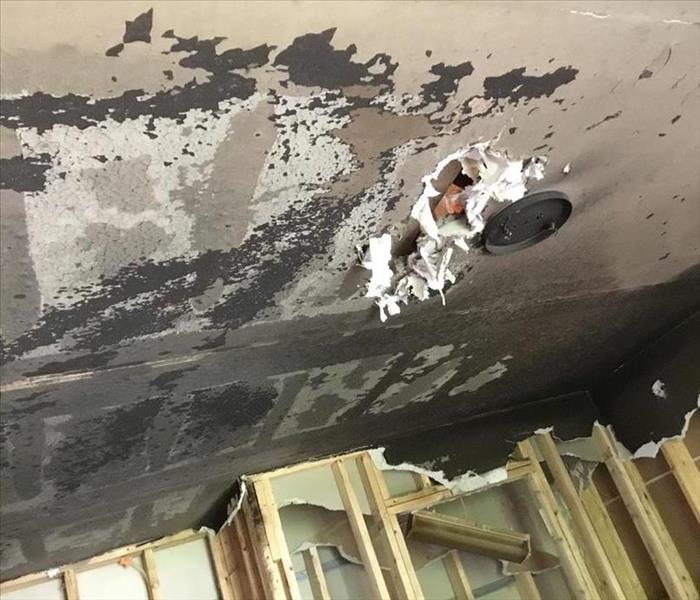 Fire while under construction
Fire while under construction
The days are longer and the weather is warmer, it's time get those construction and renovation projects underway!
Fires in structures under construction are more common than you may think.
According to the NFPA, fire departments responded to an average of 3,840 fires of structures that were under construction and 2,580 fires in structures that were under major renovations per year between 2013-2017.
The cost annually for this is $304 million in direct property damage and three of every four fires in structures under construction involved residential properties.
Fire at a construction site is bound to endanger the lives of workers and anyone else on site. A fire at the site can also damage the structure and destruction of machinery and materials; ultimately putting the job at a stop and delaying the whole project.
It is imperative that every project has a clearly laid out fire protection plan and a project manager/construction manager to make sure that the plan is in place and that every one is aware of the plan and point of contact.
Fires at construction sites can start for many reasons and it is important to know fire types and how to handle each one.
Class A fires occur in wood, rubber, paper,cloth and most plastics. The most effective type of extinguishing agent is one using water, or solutions containing large concentrations of water,because the ‘‘quenching-cooling’’ effect reduces the temperature of the burning material below its ignition temperature. Fire extinguishers suitable for this type of fire are designated with a classification of “A” on the label
Class B fires occur in flammable or combustible liquids, such as petroleum products and greases.
A “blanketingsmothering” effect of an agent that excludes oxygen or inhibits the chemical chain reaction is most effective. Extinguishers labeled “Class B” employ carbon dioxide, dry chemical, Halon or foam.
Class C fires involve electrical equipment. The extinguishing agent must be non-conductive. Carbon dioxide, dry chemical and Halon are the normal types used for electrical fires.
Class D fires involve combustible metals such as aluminum, magnesium, zirconium and titanium. The use of water and some other conventional types of extinguishing agents are ineffective and may cause a violent reaction. These fires can be extinguished with specially prepared agents. Where this hazard exists, extinguishing agents with a D-class rating should be provided. All on-site fire extinguishers should be serviced and inspected.
According to the NSC, The woodworking area should be set up in a remote area of the project.
Where possible, dust-collecting apparatus should be installed for power equipment. Dust, scraps and refuse should be removed regularly and properly disposed of. Smoking should be prohibited in the area.
Cutting and welding sparks cause more
construction fires than any other ignition source.
The person responsible for fire safety should implement fire protection systems and ensure
adequate precautions are taken.
The NSC also recommends to expedite the installation of automatic sprinklers.
Underground mains, hydrants and a source of
water should be provided in the earliest stages of
construction. The goal should be to get sprinklers
in service ahead of combustible occupancy and
immediately following combustible construction.
Making sure that all local codes are being implemented and followed is imperative to a safe and effective worksite.
SERVPRO of Lebanon/Hanover/Littleton welcomes any and all questions about fire safety! Give us a call today at 603-298-6942
Which Fire Extinguisher should I use?
5/4/2022 (Permalink)
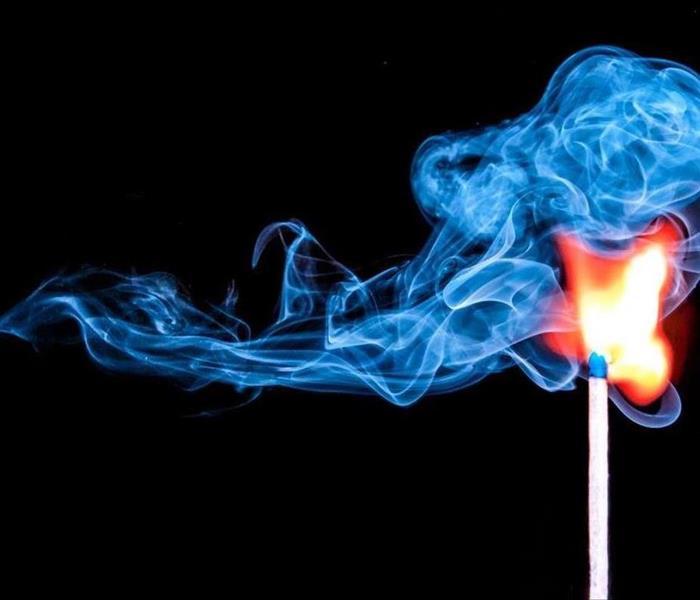 Do you know how to put this fire out?
Do you know how to put this fire out?
Know your fire types so that you can be prepared.
Not all fires are the same and that means not all fires are handled the same. For example, you would never want to throw water onto a grease fire. Learning about fire, can save your life.
Let's take a look at the different types of fires and their classification.
Fire Classes:
Class A: Ordinary Combustibles
- Wood
- Paper
- Cloth
- Trash
- Other ordinary materials
Class B: Flammable Liquids
- Gasoline
- Paints
- Oils
- Grease
- Other flammable Liquids
Class C: Electrical Equipment
Class D: Combustible Metals
- Combustible metal and metal alloys such as Aluminum and Magnesium.
Class K: Combustible Cooking
- Cooking Vessels
- Vegetable oils
- Animal Fats
- kitchen fires
Now that we have learned about the different types and classifications of fire, Let's find out which extinguisher is appropriate for each fire type.
There are a few different types of fire extinguishers available and each serves it's own purpose.
Types of extinguishers:
Water: This extinguisher is for use on Class A fires.
This type is used on paper, wood, coal, cardboard and other solid fuel fires.
Foam: This extinguisher is for use on Class A and B fires.
- This type can be used on paper, wood, coal, cardboard and other solid fuel fires. This type is used on paper, wood, coal, cardboard and other solid fuel fires.
Powder: This extinguisher is for use on Class A,B,C,D and Electrical.
- This type is used on paper, wood, coal, cardboard and other solid fuel fires.
- This type can also be used on flammable liquids, Flammable Metals, Flammable Gases and Electrical.
CO2:This extinguisher is for use on Class B and Electrical fires.
- This type is used on Flammable Liquids and Electrical fires.
Wet Chemical: This extinguisher is for use on Class A and K fires.
- This type is used on paper, wood, coal, cardboard and other solid fuel fires
- Cooking Oil fires such as a deep fat fryer.
Fires spread quick and can be deadly!
Knowing what type of fire extinguisher to use and having it readily available can make all the difference in the world.
If you have any questions about fire remediation or just want to learn more about fire prevention; give us a call at 603-298-6942 or visit our website for blogs and more.
Holiday Safety facts 2.0
12/6/2021 (Permalink)
 Holiday Safety
Holiday Safety
The holidays are so much fun, especially for the kids!
Gathering with family, wrapping presents, putting up the tree, the smells of delicious foods and treats abound. We ALL want a safe holiday season and here are some facts to keep you having fun throughout the whole holiday season.
Did you know that electrical distribution or lighting equipment was involved in almost half of home Christmas tree fires?
According to NFPA
Nearly one in five Christmas tree fires were started by decorative lights. Eight percent were started by candles.
Roughly two of every five home Christmas tree fires started in the living room.
Christmas tree & decoration fires
Carefully decorating your home can help make your holidays safer. Between 2015-2019, U.S. fire departments responded to an average of 160 home fires that started with Christmas trees per year. U.S. fire departments responded to an estimated average of 790 home structure fires per year that began with decorations, excluding Christmas trees.
As Christmas trees dry out, they become more and more flammable. Thirty percent of Christmas tree fires were in January. Although Christmas tree fires are not common, they can grow very fast.
U.S. fire departments responded to an estimated average of 790 home structure fires per year that began with decorations, excluding Christmas trees, in 2015-2019. These fires caused an annual average of one civilian fire death, 26 civilian fire injuries and $13 million in direct property damage.
Year-round, more than one-third of home decoration fires were started by candles. Cooking started 19 percent of decoration fires, 12 percent involved electrical distribution and lighting equipment, heating equipment was involved in 11 percent, 8 percent were intentionally set, and smoking materials started 7 percent.
Candles
Between 2015-2019, U.S. fire departments responded to an average of 7,400 home fires that were started by candles. These fires caused an average of 90 civilian deaths, 670 civilian injuries and $291 million in direct property damage.
On average, 20 home candle fires were reported each day between 2015-2019.
Candle fires peak in December and January with 11 percent of candle fires in each of these months.
Christmas is the peak day for candle fires with roughly 2.5 times the daily average.
Holiday cooking
Cooking equipment was involved in one of every five (19%) of home decoration fires.
This can happen when a decoration is left on or too close to a stove or other cooking equipment.
In 2019, the three leading dates for home structure fires caused by cooking were, Thanksgiving, Christmas day and Christmas Eve.
For more information on how to keep your family safe in the kitchen this holiday season, follow this informative link: Cooking Safety
For more fire tips and tricks, visit our SERVPRO fire blogs at Fire Safety
"Like it never even happened."
Learning about Fire during the Holiday season
10/20/2021 (Permalink)
A fire can happen to anyone at anytime, but the Holiday season is peak season!
Winter is quickly approaching as well as the holiday season. This time of year automatically raises the chances of fire in our homes. Many of us in the Northeast have woodstoves that heat our homes, upping the risk of fire and puffback.
The holiday season brings with it another element of fire concern, We need to concern ourselves with kitchen safety! We do a lot of cooking and baking during the holiday season.
According to the NFPA, Thanksgiving is the peak day for home cooking fires, followed by Christmas Day, the day before Thanksgiving, and Christmas Eve.
Now that we know how prevalent fires are around the holiday season, Let's Learn about FIRE!
Here are some Facts and Tips about Fire:
Fire is FAST! In less than 30 seconds a small flame can turn into a major fire. It only takes minutes for thick black smoke to fill a house or for it to be engulfed in flames.
Fire is HOT! Heat is more threatening than flames. Room temperatures in a fire can be 100 degrees at floor level and rise to 600 degrees at eye level. Inhaling this super-hot air will scorch your lungs and melt clothes to your skin.
Fire is DARK! Fire starts bright, but quickly produces black smoke and complete darkness.
Fire is DEADLY! Smoke and toxic gases kill more people than flames do. Fire produces poisonous gases that make you disoriented and drowsy. Asphyxiation is the leading cause of fire deaths, exceeding burns by a three-to-one ratio.
Before a Fire Occurs
Create and Practice a Fire Escape Plan
Twice each year, practice your home fire escape plan. Some tips to consider when preparing this plan include:
Find two ways to get out of each room in the event the primary way is blocked by fire or smoke.
A secondary route might be a window onto a neighboring roof or a collapsible ladder for escape from upper story windows.
Make sure that windows are not stuck, screens can be taken out quickly, and that security bars can be properly opened.
Practice feeling your way out of the house in the dark or with your eyes closed.
Teach children not to hide from firefighters.
Smoke Alarms
A working smoke alarm significantly increases your chances of surviving a deadly home fire.
Test batteries monthly.
Install smoke alarms on every level of your home, including the basement, both inside and outside of sleeping areas.
Never disable a smoke alarm while cooking – it can be a deadly mistake.
During a Fire
Crawl low under any smoke to your exit - heavy smoke and poisonous gases collect first along the ceiling.
Before opening a door, feel the doorknob and door. If either is hot, or if there is smoke coming around the door, leave the door closed and use your second way out.
If you open a door, open it slowly. Be ready to shut it quickly if heavy smoke or fire is present.
If pets are trapped inside your home, tell firefighters right away.
If you can’t get out, close the door and cover vents and cracks around doors with cloth or tape to keep smoke out. Call 9-1-1 or your fire department. Say where you are and signal for help at the window with a light-colored cloth or a flashlight.
If your clothes catch fire, stop, drop, and roll – stop immediately, drop to the ground, and cover your face with your hands. Roll over and over or back and forth until the fire is out. If you or someone else cannot stop, drop, and roll, smother the flames with a blanket or towel.
Use cool water to treat the burn immediately for 3 to 5 minutes. Cover with a clean, dry cloth. Get medical help right away by calling 9-1-1 or the fire department.
After a Fire
Contact your local disaster relief service, such as The Red Cross, if you need temporary housing, food and medicines.
Check with the fire department to make sure your residence is safe to enter. Be watchful of any structural damage caused by the fire.
The fire department should see that utilities are either safe to use or are disconnected before they leave the site. DO NOT attempt to reconnect utilities yourself.
If you are insured, contact your insurance company.
Try to locate valuable documents and records.
You will need a Fire Damage and Restoration team. Contact SERVPRO of Lebanon/Hanover/Littleton at 603-298-6942 24 hours a day.
Fire Prevention Week and what comes next!
10/13/2021 (Permalink)
October 3rd through October 9th was Fire Prevention Week and armed with the latest information, now is the time to put it all to good use!
Here are some tips on staying on top of all things fire related.
Protect Your Family with Smoke Detectors
Installing and maintaining smoke detectors is still the most important step you can take to protect your family from fire death or injury.
The detector should be no more than ten years old.
You can check the date on the back of the unit. Test the batteries monthly, and replace often. Install them in all bedrooms, hallways outside bedrooms, and on each level of your home.
There are two types of smoke detectors: photoelectric and ionization.
Photoelectric works better with slower, smoldering fires, while the ionization type is more suited to faster, flaming fires.
Most experts recommend that you have both in your home.
Have an Escape Plan
Take the time to plan an escape route for everyone in the home, designating a “meet up spot” outside.
The key to any escape plan is practice, practice and more practice!
Kids love games and challenges. Record the time it takes everyone to make it from their beds to the meet up spot, and then try to beat that time. The more often you practice, the more likely your children are to follow the plan, rather than freeze in panic or confusion when every second counts. Set your calendar to remind you to practice monthly.
For detailed information on how to create an escape plan for your family, https://www.ready.gov/ has a ton of useful information. Follow this helpful link: Fire escape plan
Fire Extinguishers are a must!
Two out of five home fires begin in the kitchen. Never leave a kitchen when food is cooking, especially on the burners. ALWAYS keep a fire extinguisher close by!
Have your chimneys cleaned regularly, and be very careful with portable space heaters. Make sure they are several feet away from drapes, clothing, or anything that could catch fire.
Never smoke in bed or while lying down.
With the Holidays coming, decorating our homes is a tradition, but it's a tradition that we must do safely..
Inspect your appliance cords. If any are torn, ripped, or damaged in any way, replace them immediately. If a cord or plug ever feels hot, unplug it.
Prevention is the key to your safety because the weather is turning colder here in the Northeast! The Holidays are just around the corner! We have to remain vigilant with our fire safety.
Spring Clean up and Fire Safety
5/5/2021 (Permalink)
Spring has sprung!
Spring cleaning often starts with our garage, now is the perfect time to clean out all stored newspapers or other rubbish that can be fuel for a fire.
Properly dispose of oily or greasy rags. If these items must be stored, they should be kept in
labeled and sealed metal containers.
If you store gasoline, keep it outside your home in a shed or detached garage.
Keep only small quantities in tightly sealed containers. Use gasoline only as a motor fuel, never as a cleaning agent or charcoal accelerant.
Things to remember when Spring Cleaning begins indoors and out:
- It's good practice to change batteries in smoke alarms, flashlights and carbon monoxide detectors in the Spring and Fall.
- Replace all smoke alarms every 10 years or as recommended by the manufacturer.
- Be sure to thoroughly clean the lint trap in your clothes dryer. Failure to clear lint from the filter is the leading cause of home clothes dryer fires.
- Remove anything from your stovetop that could pose a dangerous fire hazard. This includes oven mitts, wooden utensils, food packaging and hand towels.
- Make sure outlets are not overcrowded with electrical wires and extension cords and that no extension cords are running across doorways or under carpets.
- Loose debris, like old rags, papers, tissue and wrapping paper, clothing and blankets, which pile up in closets, drawers or cabinets should be cleared out. (They create a fire hazard in your home).
- While cleaning, try to pay particular attention for loose floor boards or stair posts, sharp edges on furniture, tripping hazards or toxic materials left out in the open. This is the perfect time of year for stepping up the safety inside your home.
- This is a perfect time to go over your family's fire escape plan and make any changes if needed. Practice, Practice, Practice.
- Remember to Keep outdoor debris or dead vegetation away from the house and barbecue grill.
Speaking of our grill. Spring is a great time to make sure that our grills are in working order.
According to the NFPA, three out five households owns a gas grill, which translates to a lot of grilling. But it also means there’s an increased risk of home fires.
July is the peak month for grill fires at 17 percent, including both structure, outdoor or unclassified fires, followed by May, June and August.
A failure to clean the grill was the leading factor contributing to the fire in 19 percent of all grill structure fires. In 17 percent of the fires, something that could catch fire was too close to the grill.
Gas grills contribute to a higher number of home fires overall than their charcoal counterparts.
Spring is a great time to get a fresh start inside and out! If you need some help with your Spring cleaning, give us a call today at 603-298-6942.
Holiday Fire Safety Tips!
12/4/2020 (Permalink)
Watch Out for Those Fire-starters!
Candles and Fireplaces
Thousands of deaths are caused by fires, burns and other fire-related injuries every year, and 12% of home candle fires occur in December, the National Fire Protection Association reports. Increased use of candles and fireplaces, combined with an increase in the amount of combustible, seasonal decorations present in many homes means more risk for fire.
Top Ten Holiday Safety Tips
- Inspect electrical decorations for damage before use.
Cracked or damaged sockets, loose or bare wires, and loose connections may cause a serious shock or start a fire. - Do not overload electrical outlets. Overloaded electrical outlets and faulty wires are a common cause of holiday fires. Avoid overloading outlets and plug only one high-wattage into each outlet at a time.
- Never connect more than three strings of incandescent lights,
More than three strands may not only blow a fuse, but can also cause a fire. - Keep trees fresh by watering daily,dry trees are a serious fire hazard.
- Use battery-operated candles,candles start almost half of home decoration fires (NFPA).
- Keep combustibles at least three feet from heat sources.
- Protect cords from damage. To avoid shock or fire hazards, cords should never be pinched by furniture, forced into small spaces such as doors and windows, placed under rugs, located near heat sources, or attached by nails or staples.
- Check decorations for certification label. Decorations not bearing a label from an independent testing laboratory such as Underwriters Laboratories (UL), Canadian Standards Association (CSA), or Intertek (ETL) have not been tested for safety and could be hazardous.
- Stay in the kitchen when something is cooking. Unattended cooking equipment is the leading cause of home cooking fires (NFPA).
- Turn off, unplug, and extinguish all decorations when going to sleep or leaving the house. Unattended candles are the cause of one in five home candle fires. Half of home fire deaths occur between the hours of 11pm and 7am (NFPA).
We hope that these tips have been helpful to you, and everyone here at SERVPRO of Lebanon/Hanover/Littleton wishes you a SAFE and Happy Holidays!
Fire Prevention Week and Beyond
10/12/2020 (Permalink)
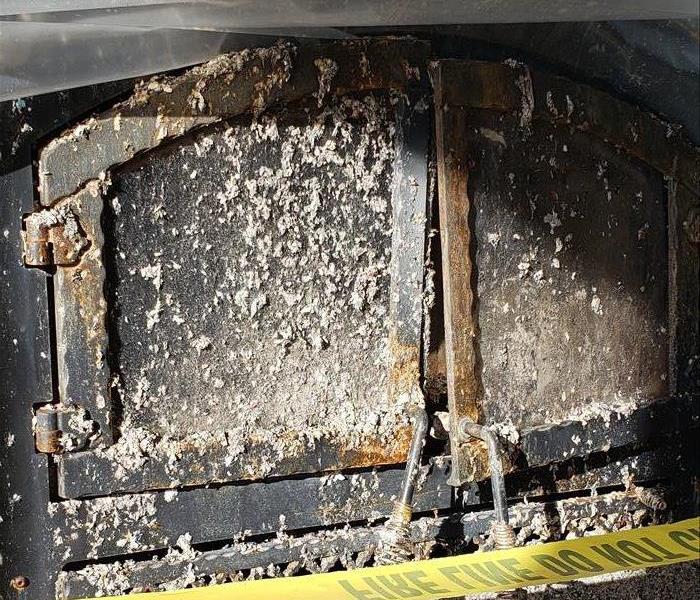 Fire Safety
Fire Safety
October 7th through October 13th is Fire Prevention Week.
The weather is turning colder here in the Northeast! The Holidays are just around the corner! We have to remain vigilant with our fire safety. Here are some tips on staying on top of all things fire related.
Protect Your Family with Smoke Detectors!
Installing and maintaining smoke detectors is still the most important step you can take to protect your family from fire death or injury.
The detector should be no more than ten years old. You can check the date on the back of the unit. Test the batteries monthly, and replace often. Install them in all bedrooms, hallways outside bedrooms, and on each level of your home.
There are two types of smoke detectors: photoelectric and ionization. Photoelectric works better with slower, smoldering fires, while the ionization type is more suited to faster, flaming fires. Most experts recommend that you have both in your home.
Have an Escape Plan
Take the time to plan an escape route for everyone in the home, designating a “meet up spot” outside.
The key to any escape plan is practice, practice and more practice!
Kids love games and challenges. Record the time it takes everyone to make it from their beds to the meetup spot, and then try to beat that time. The more often you practice, the more likely your children are to follow the plan, rather than freeze in panic or confusion when every second counts. Set your calendar to remind you to practice monthly.
Fire Extinguishers are a must!
Two out of five home fires begin in the kitchen. Never leave a kitchen when food is cooking, especially on the burners. ALWAYS keep a fire extinguisher close by!
Have your chimneys cleaned regularly, and be very careful with portable space heaters. Make sure they are several feet away from drapes, clothing, or anything that could catch fire.
Never smoke in bed or while lying down.
With the Holidays coming, decorating our homes is a tradition, but it's a tradition that we must do safely.
Inspect your appliance cords. If any are torn, ripped, or damaged in any way, replace them immediately. If a cord or plug ever feels hot, unplug it.
Prevention is the key to your safety.
Fire Safety during a drought Part 2
10/9/2020 (Permalink)
Fire Safety during a drought part 2!
We've experienced a very dry Spring and Summer this year. It's very important to remember to be cautious while your out and about and when doing yard work around your home. It only takes a spark to trigger a fire that could have devastating consequences.
According to WMUR, Most of northern New England is in the midst of a drought
after three months of low rainfall.
The State Drought Monitor maintained by
the University of Nebraska lists most of Maine and New Hampshire as facing "severe drought" and "moderate drought" conditions.
In our previous blog we discussed fire safety during a drought and how to prevent fires from occurring..This is a follow up to our original discussion! Onto part 2 of Fire Safety!!
Here are more measures that we can take to prevent fires..
Store your firewood safely
Stack firewood at least 15 feet away and uphill from your home.
Cook Safely Outdoors
If you are someone that enjoys barbecuing during the Fall as well as the Summer, here are some tips to keep it safe: Maintain a 10-foot brush free zone around outdoor grills and propane tanks. If using a charcoal grill, it is recommended that you place leftover ashes in a metal container and douse with water.
NEVER leave any grill unattended.
Fall means Football and outdoor events!
Where you park your car makes a difference. If possible, do not park vehicles and other motorized vehicles on or near dry grass or shrubbery.
Exhaust systems can exceed the 500 degrees that it takes to start a brush fire.
Have a Fire extinguisher on hand
Having a fire extinguisher and other fire suppressing tools on you at all times is important during times of drought. Some helpful tools can be a shovel, bucket (for water) and a hose that can reach around your home and outlying areas.
Cigarettes and Cigars can be big fire starters if thrown out of a car window or tossed onto grass.
Teach children and everyone in your home fire safety and have a safety plan in place.
Teach children about the dangers of playing with fire and make sure that they know what to do in case of a fire! Including a fire evacuation plan.
Planning for a fire today can save a life tomorrow!
Fire Safety during a drought Part 1
10/2/2020 (Permalink)
We've experienced a very dry Spring and Summer this year.
It's very important to remember to be cautious while you're out and about and when doing yard work around your home. It only takes a spark to trigger a fire that could have devastating consequences.
According to WMUR, most of northern New England is in the midst of a drought
after three months of low rainfall.
The State Drought Monitor maintained by
the University of Nebraska lists most of Maine and New Hampshire as facing "severe drought" and "moderate drought" conditions.
There are precautions that we can take to prevent a fire during times of drought. Some of them are:
DO NOT burn brush, leaves or trash outdoors!
Create a safety zone.
Maintain a 30-foot or greater safety zone around your home that is clear of brush, tall grass and other flammable vegetation. Fire moves more quickly up steep hills, so extend that fire safety zone if your home is situated on a steep slope.
If you're considering planting, use fire resistant species of plants and trees throughout your property and especially within your safety zone.
Maintain your lawn
Keep trees and shrubs pruned around the chimney outlets and stovepipes. Keep your yard mowed, raked and free of brush and dead limbs.
Vehicles and Equipment
Something that we may not think of is "Spark Arresters." These are special mufflers that suppress fire starting sparks on any vehicle or equipment with an internal combustion engine. Use an approved spark arrester on chimneys and
stovepipes to stop the escape of burning cinders.
Let's usher fall in safely, everyone! And keep your eyes peeled for part 2 of Fire Safety during a drought.
DRYERS and the danger they pose!
4/22/2020 (Permalink)
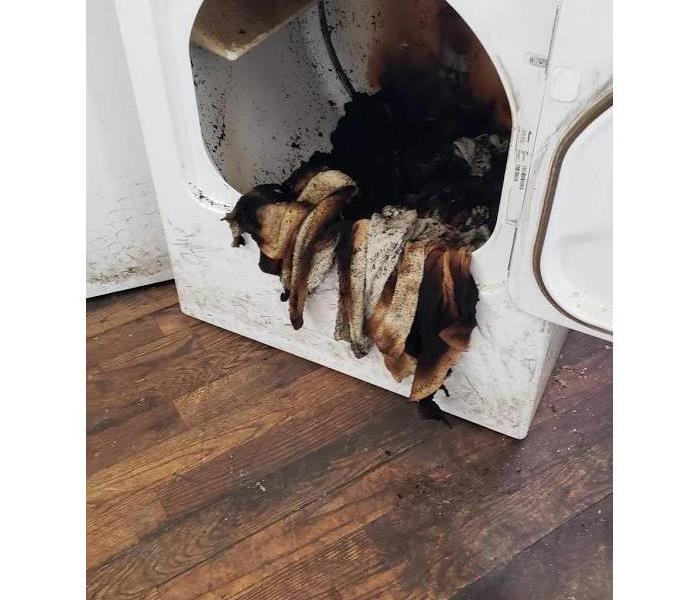 Dryer Fire!
Dryer Fire!
According to FEMA, 2,900 home clothes dryer fires are reported each year and
cause an estimated 5 deaths, 100 injuries, and $35 million in property loss.
There are some do's and don'ts when it comes to dryer safety! Let's take a look at some.
What you should DO:
- Have your dryer installed by a professional. This may seem unnecessary to some, but
incorrect installation can put you and your family at risk. - Making sure that the dryer is plugged into the correct plug with the correct
voltage, A standard electric dryer generally draw about 30 amps at a voltage
of 220 volts. - Clean the lint filter before and after each load of laundry. Don’t forget to
clean the back of the dryer where lint can build up. In addition, clean the
lint filter with a nylon brush at least every six months or more often if it
becomes clogged. - Make sure to clean the lint vent pipe out every three months.
- If you notice that your dryer is taking longer than usual to dry your clothes,
a professional cleaning may be in order.
What you DON'T want to do:
- Don't overload your dryer..You must allow for enough air exchange
- Never use a dryer without a lint filter
- Do not use cloth or wire screen to cover the outer vent (wall damper). They
will collect lint and dirt and potentially clog the vent. - Don't dry anything containing foam, rubber or plastic
- Never dry anything that has come into contact with cooking oil, gasoline or
alcohol. All are flammable. Dry them outside or in a very well ventilated
area. - Never leave your dryer running while you are out of the home.
These are just some tips for your safety, to learn more about fire safety follow these helpful links:
FEMA
SERVPRO fire restoration
If you have any questions about fire and fire safety, call us today at 603-298-6942. We're always here to help!
Smoke and Odor damage! The mess that fire leaves behind!
2/3/2020 (Permalink)
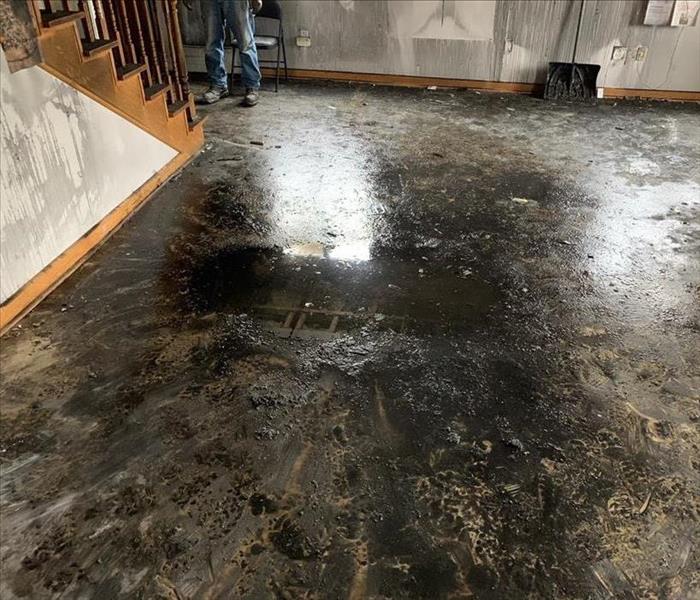 Smoke Damage!
Smoke Damage!
Fire is not the only destructive force! Smoke and the Odor it leaves behind can be devastating.
When a fire occurs in your home, it's not always a total loss, but the mess that is left behind from the smoke and the putting out of the fire itself; can make it seem like a total loss! Smoke gets into every nook of your home and the odor that is left behind is foul and strong.
Smoke affects various materials in different ways. The temperature and type of the fire can cause different variations of smoke that will damage your home in different ways. Smoke is actually made of small particles of the fire itself. It is toxic and hot particles that damages the surfaces as it lands on it.
Not all fires are big fires, and not all smoke damage is caused by a direct fire. In fact, it's the fires that we don't think that much about, like smoke from a fire outside that sneaks into your home. This type of smoke damage can go unnoticed for a long time, all the while damaging the surface that it's on as well as leaving behind a lingering odor.
You may find yourself wanting to brave the mess yourself if you find yourself with smoke damage, BUT it's not always the safest for you to do on your own. If you have suffered a house fire, chances are that the conditions are unsafe. The structure may have falling pieces yet and the smoke damage combined with the water is extremely slippery.
Odds are that if a fire has occurred, there will be a need to secure the area and clean up the debris before a decision can be rendered on it's safety.
Thankfully, SERVPRO of Lebanon/Hanover/Littleton can help with this. We have the equipment and experience to secure
your home and get it ready for Restoration.
Every fire presents it's own set of circumstances and poses it's own set of problems, there is a general process that is followed.
- Emergency Contact (When you first call us).
- Inspection and Fire Damage Assessment.
- Immediate Board-Up and Roof Tarp Service (if needed)
- Water Removal and Drying (if water damage is present)
- Removal of Smoke and Soot from All Surfaces.
- Cleaning and Repair
- Restoration
Odor elimination is a big part of the Restoration process as well. SERVPRO technicians are IICRC certified in odor removal.
Some odor removal basics are as follows
- Remove the source of the odor. ie burnt wood and building materials safely
- Clean up begins and the deodorization begins. Smoke and soot residues can deposit on and even penetrate the various surfaces such as walls and ceilings. SERVPRO technicians clean
different surfaces depending on the type of the surface and residue deposited on it. - Sealing if needed. Generally, sealing is not needed. But if the damage is extensive and the removal of the source is to expensive or impractical; it is the recommended option.
If you believe that you have unchecked smoke damage or have lingering odors, give us a call today at 603-298-6942 and we'll gladly come tackle that for you!
Holiday Safety before you decorate
12/4/2019 (Permalink)
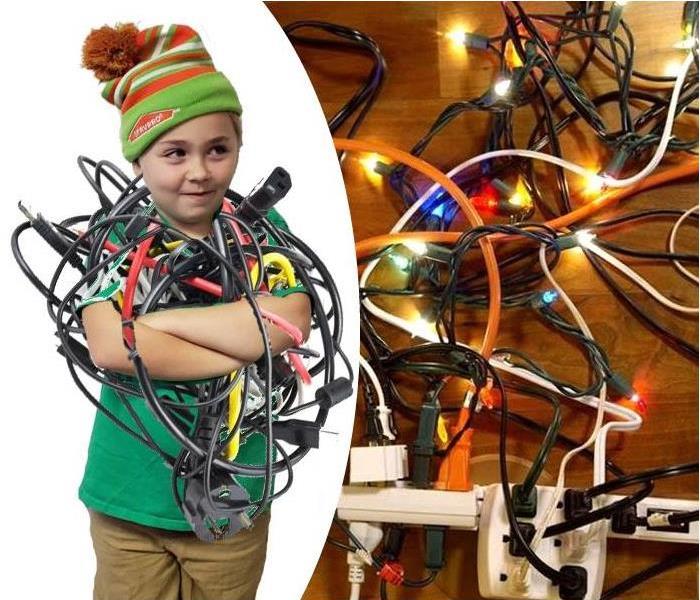 Don't overload when decorating
Don't overload when decorating
The Holidays are right around the corner and now is the time to get the decorations out!
Around the holidays we need to be extra careful not to overload our plugs and extension cords. You could lose your power or even worse, start a FIRE!
According to the NFPA Electrical distribution or lighting equipment was involved in more than two of every five (44%) home Christmas tree fires.
Two of every five (39%) home Christmas tree fires started in the living room. Five percent were chimney or flue fires. One-fifth (21%) of the decoration fires started in the kitchen. Sixteen percent started in the living room, family room or den.
Almost three of every five (57%) December home decoration fires were started by candles, compared to one-third (32%) in January to November.
Carefully decorating your home can help make your holidays safer.
Between 2013-2017, U.S. fire departments responded to an average of 160 home fires that started with Christmas trees per year. U.S. fire departments responded to an estimated average of 780 home structure fires per year that began with decorations, excluding Christmas trees.
Make sure that your extension cords are not twisted and are in good working order as well as all lights be checked and are in good working order before you use them.
For more Holiday fire safety tips: Click here
SERVPRO of Lebanon/Hanover/Littleton wants to wish everyone a happy and SAFE Holiday season!
Fire and the odor it leaves behind
11/1/2019 (Permalink)
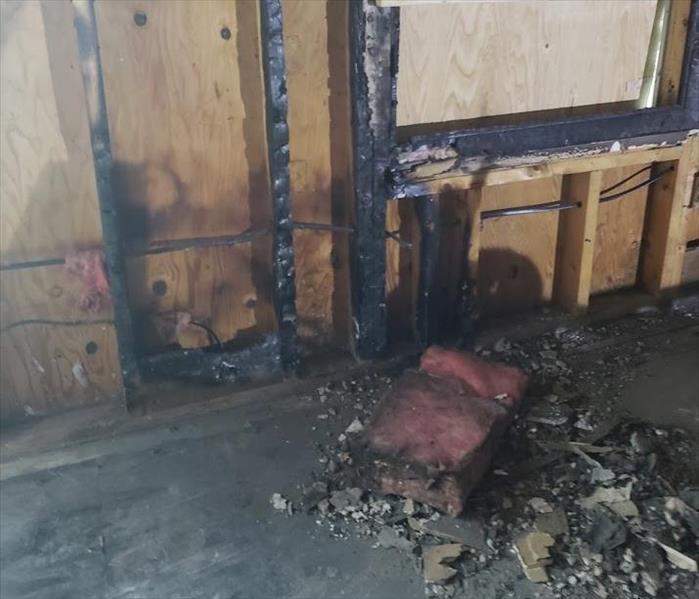 Fire Damage
Fire Damage
Things You Should Know about deodorizing your home after a fire.
One problem to consider after a fire is the lingering foul odor. If the odor is not taken care of professionally, it can linger for a very long time; making it hard to live with.
Thankfully, SERVPRO of Lebanon/Hanover/Littleton can help you get rid of this odor.
The odor after a fire is a mix of chemical and natural odors due to the burning of wood, plastic, and various materials.
SERVPRO employs a multi-step process to eliminate odor and get your home smelling like home again.
Here are some odor removing basics
- Removing the source
One of the first things that SERVPRO technicians do while tackling an odor problem after a fire is removing the source of the odor. The source of odor after a fire damage can be burnt wood or other building materials. Our IICRC certified technicians dispose of the source in a safely and efficiently.
- Clean up
The second step during the deodorizing process is cleaning. Smoke and soot residues can deposit on and even penetrate the various surfaces such as walls and ceilings. SERVPRO technicians clean different surfaces depending on the type of the surface and residue deposited on it.
- Sealing
Sealing is not required in most cases, but if the damage is extensive and the removal of the source is too expensive or impractical, it is the best option.
If you have some lingering odors in your home or just have some questions about our process, give us a call today at 603-298-6942.
Fire hazards in the kitchen
10/14/2019 (Permalink)
Our kitchens are the hub of most homes and a place to gather together, But our kitchens are also the most dangerous room in the house when it comes to fire!
According to the NFPA, Cooking fires are the number one cause of home fires and home injuries. The leading cause of fires in the kitchen is unattended cooking.
Follow these Safety Tips for Cooking
Staying in the kitchen to keep watch over what is cooking is not the only fire safety tip you should be following.
- Watch out for your clothing. If you are wearing long, flowing sleeves or big, baggy clothing, it could catch on fire if you aren’t careful and it comes into contact with an open flame or a stove’s hot surface. It’s best to wear short or close-fitted sleeve shirts and make sure any baggy shirts are tucked in or tied back.
- Watch the items that are placed around or on the stovetop. Kitchen towels, oven mitts, appliance cords or even curtains too close to the stovetop when cooking are quick to catch fire. Ideally, anything flammable needs to be moved away from it.
- There needs to be a fire extinguisher in or near the kitchen. Hopefully you have at least one fire extinguisher located in your home near your kitchen. Be sure that you know how to properly use the extinguisher, just in case it is ever needed.
- Hot grease should not be thrown in the garbage can. While the grease may not be on fire, it may just be hot enough to cause something in the trash to ignite and burn. Let the grease cool for a while before disposing of it in an old coffee can. Also, know the “smoke point” temperatures of oils you cook with. Never subject a low-smoke point oil to high heat when cooking, as it could catch fire.
- Create and establish an escape plan in the event of a fire. Who wants to thinks about worst-case scenarios? Nobody, but it’s better to be prepared should an emergency occur. Go over exit routes and designated meeting points with your family, making sure that everyone knows what to do.
Fire safety in the kitchen is an absolute necessity, as it can help prevent dangerous and destructive cooking fires. If your home has experienced damage from a cooking fire, know that SERVPRO of Lebanon/Hanover/Littleton is here to make it “Like it never even happened.”
Top Ten reasons for house fires and how to avoid them.
10/11/2019 (Permalink)
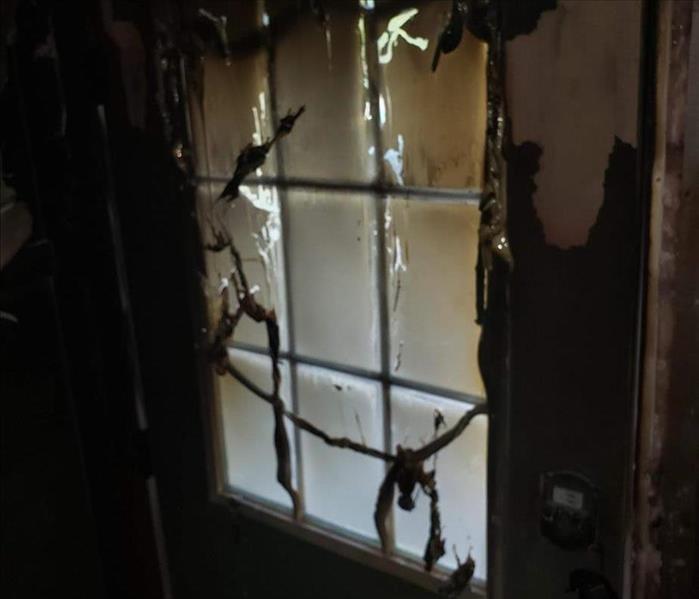 Fire Prevention is key
Fire Prevention is key
Top Ten reasons for house fires and how to avoid them.
The thought of your home burning down is a nightmare and we all hope that this won't happen to us, but knowledge is our best tool and knowing the causes of fire can help us prevent it.
Cooking equipment
Pots and pans can overheat and cause a fire very easily if the person cooking gets distracted and leaves cooking unattended. Always stay in the room, or ask someone to watch your food, when cooking on hotplates.
Heating
Keep portable heaters at least 3 feet away from anything that could easily catch fire such as furniture, curtains, laundry, clothes and even yourself. If you have a furnace, get it inspected once a year to make sure it is working to safety standards.
Smoking in bedrooms
Bedrooms are best to be kept off limits for smoking. A cigarette that is not put out properly can cause a flame, as the butt may stay alit for a few hours. It could burst into flames if it came into contact with flammable materials, such as furniture.
Electrical equipment
An electrical appliance, such as a toaster can start a fire if it is faulty or has a frayed cord. A power strip that is overloaded with double adapter plugs can cause a fire from an overuse of electricity.
Candles
Candles look and smell pretty, but if left unattended they can cause a room to easily burst into flames. Keep candles away from any obviously flammable items such as books and tissue boxes and curtains. Always blow a candle out before leaving a room.
Curious children
Kids can cause a fire out of curiosity, to see what would happen if they set fire to an object. Keep any matches or lighters out of reach of children. Install a smoke alarm in your child’s room and practice a home escape plan with your children and family in case there was a fire.
Faulty wiring
Homes with inadequate wiring can cause fires from electrical hazards. Some signs to see if you’ve bad wiring are:
- Lights dim if you use another appliance.
- For an appliance to work, you have to disconnect another.
- Fuses blow or trip the circuit frequently.
Have a licensed electrician come and inspect you house, or contact your landlord if you have any of the above occurrences.
Barbecues
Barbecues are a great way to cook in the warmer months, but should always be used away from the home, tablecloths or any plants and tree branches.
Check the gas bottle for any leaks before you use it each time.
Flammable liquids
If you have any flammable liquids in the home or garage such as gasoline or kerosene keep them away from heat sources and check the label before storing. Be careful when pouring these liquids.
Lighting
Lamp shades and light fittings can build up heat if they are very close to light bulbs. Check around the house to make sure. Lamp bases can become a hazard if they are able to be knocked over easily, and so should be removed if they are.
If you have any fire related questions, give us a call today at 603-298-6942.
Fire Damage Restoration basics
4/24/2019 (Permalink)
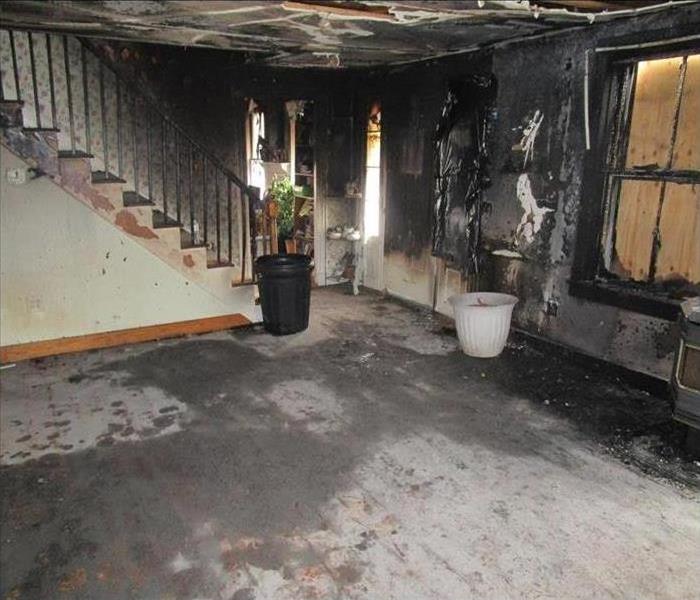 Fire damage
Fire damage
Fire is a destructive force and can leave many types of damage in it's wake!
The obvious damage comes from the fire itself as it burns, but where there is fire; there is smoke,soot,water,chemicals used to put the fire out and a host of other problems.
SERVPRO of Lebanon/Hanover/Littleton has the equipment and experience to handle your unique situation, and with a restore vs.replace mentality; it's our goal to get you back into your home asap!
Although each fire is unique and poses it's own set of problems, there is a general process that is followed.
- Emergency Contact (When you first call us).
- Inspection and Fire Damage Assessment.
- Immediate Board-Up and Roof Tarp Service (if needed)
- Water Removal and Drying (if water damage is present)
- Removal of Smoke and Soot from All Surfaces.
- Cleaning and Repair.
- Restoration
For a more in depth look into our fire damage restoration process; Click on this link.
And for questions about fire,smoke or soot damage; give us a call at 603-298-6942.
Fire Prevention is the key!
2/4/2019 (Permalink)
Common Fire Hazards
Kitchen fires from unattended cooking, grease fires
Electrical systems that are overloaded, poorly maintained or defective
Candles and other open flames
Smoking (Cigarettes, cigars, pipes, lighters, etc.)
Fireplace chimneys not properly or regularly cleaned
Heating appliances - fireplaces, wood burning stoves, furnaces, boilers, portable heaters, solid fuels.
Household appliances - clothes dryers, curling irons, hair dryers, refrigerators, freezers, boilers.
Check Your Smoke Alarms
Use Daylight Savings Time as a reminder to check your smoke alarms. Replace conventional batteries at least once a year, even if alarms are wired directly into your homes electrical system.
For the best protection, install smoke alarms on every level of your home, outside every sleeping area and in each bedroom.
Smoke alarms expire after 10 years. So if your alarm is more than 10 years old, you should install a new one.
Create and Practice a Fire Escape Plan with two ways out of every room.
Have all emergency phone numbers in an easy to see place and make sure everyone knows where they are.
Fire prevention is key! But if the worse happens, Call SERVPRO of Lebanon/Hanover/Littleton at 603-298-6942 and we'll be there to help you through this most difficult time.
Holiday safety
12/7/2018 (Permalink)
Watch Out for Those Fire-starters!
Candles and Fireplaces!!
Thousands of deaths are caused by fires, burns and other fire- related injuries every year, and 12% of home candle fires occur in December, the National Fire Protection Association reports.
Increased use of candles and fireplaces,combined with an increase in the amount of combustible, seasonal decorations present in many homes means more risk for fire.
Top Ten Holiday Safety Tips!
1. Inspect electrical decorations for damage before use. Cracked or damaged sockets, loose or bare wires, and loose connections may cause a serious shock or start a fire.
2. Do not overload electrical outlets.
Overloaded electrical outlets and faulty wires are a common cause of holiday fires. Avoid overloading outlets and plug only one high-wattage into each outlet at a time.
3. Never connect more than three strings of incandescent lights. More than three strands may not only blow a fuse, but can also cause a fire.
4. Keep trees fresh by watering daily,dry trees are a serious fire hazard.
5. Use battery-operated candles,candles start almost half of home decoration fires (NFPA).
6. Keep combustibles at least three feet from heat sources.
7. Protect cords from damage.
To avoid shock or fire hazards, cords should never be pinched by furniture, forced into small spaces such as doors and windows, placed under rugs, located near heat sources, or attached by nails or staples.
8. Check decorations for certification label.
Decorations not bearing a label from an independent testing laboratory such as Underwriters Laboratories (UL), Canadian
Standards Association (CSA), or Intertek (ETL) have not been tested for safety and could be hazardous.
9. Stay in the kitchen when something is cooking.
Unattended cooking equipment is the leading cause of home cooking fires (NFPA).
10. Turn off, unplug, and extinguish all decorations when going to sleep or leaving the house. Unattended candles are the cause of one in five home candle fires. Half of home fire deaths occur between the hours of 11pm and 7am (NFPA).
We hope that these tips have been helpful to you, and everyone here at SERVPRO of Lebanon/Hanover/Littleton wishes you a SAFE and Happy Holidays!
When Furnaces Fight Back.. Puff Back Happens!
11/16/2018 (Permalink)
 Puff Back!
Puff Back!
Furnace puff back is a messy and potentially dangerous event in which smoke and soot are released into the furnace.
Puff backs often result in oily black "webs" of soot being distributed throughout the house, requiring extensive cleaning and sometimes professional restoration to clean up.
To better understand puff backs you should know what causes them and how they can be prevented.
Puff Backs
Puff backs occur when an oil-burning furnace doesn't ignite when it should. Oil vapors build up in the ignition chamber, causing an explosion when the igniter finally triggers. The explosion blows soot and other debris through the furnace's exhaust system and into the heating system, which carries it into the house. If the furnace is connected to a forced air heating system, the ducts can carry the puff back to every room of the house with an open vent.
Causes
Puff backs are caused by problems with the furnace, which leave oil in the ignition chamber that doesn't get burned. This can be caused by leaks in the oil system, bubbles in the oil line which expand and press oil out of the oil burner nozzle, the shutdown valve on the oil burner nozzle not working properly or a clog in the nozzle. Each of these problems can result in oil leaking out of the nozzle and into the combustion chamber when it isn't in operation. Oil will accumulate in the chamber until it finally ignites with a puff back explosion.
Warning Signs
Most oil-burning furnaces in danger of having a puff back give off warning signs that should indicate a problem with the furnace. Black soot on the furnace, walls or ceiling indicate that oil is burning improperly in the furnace and is leaking out of the unit. Noises such as those made by the combustion chamber while it is burning may continue after the furnace has stopped, indicating that something is still burning within the furnace even though it shouldn't be. Noises at the beginning of the burn cycle, such as a puff or bang, also indicate that unburned oil has pooled and ignited.
Preventing Puff Backs
Preventing puff backs in oil-burning furnaces is largely a matter of performing regular maintenance on the furnace to keep it in proper operating condition. Oil-burning appliances should be cleaned and serviced once per year, ensuring that the service person opens the unit and inspects it for signs of problems or damage. Inspect the furnace periodically for signs of oil leaks, paying attention to any odd smells or soot in the furnace room. You should also look for debris in the flue vent connector which could also be a sign of problems with the furnace.
Let's Learn about FIRE!
11/2/2018 (Permalink)
A Fire can happen to anyone at anytime!
Here are some Facts and Tips about Fire:
Learn About Fire
- Fire is FAST! In less than 30 seconds a small flame can turn into a major fire. It only takes minutes for thick black smoke to fill
a house or for it to be engulfed in flames. - Fire is HOT! Heat is more threatening than flames. Room temperatures in a fire can be 100 degrees at floor level and rise to 600 degrees at eye level. Inhaling this super-hot air will scorch your lungs and melt clothes to your skin.
- Fire is DARK! Fire starts bright, but quickly produces black smoke and complete darkness.
- Fire is DEADLY! Smoke and toxic gases kill more people than
flames do. Fire produces poisonous gases that make you disoriented and drowsy. Asphyxiation is the leading cause of fire
deaths, exceeding burns by a three-to-one ratio.
Before a Fire
Create and Practice a Fire Escape Plan!
Twice each year, practice your home fire escape plan. Some tips to consider when preparing this plan include:
- Find two ways to get out of each room in the event the primary way is blocked by fire or smoke.
- A secondary route might be a window onto a neighboring roof or a collapsible ladder for escape from upper story windows.
- Make sure that windows are not stuck, screens can be taken out quickly, and that security bars can be properly opened.
- Practice feeling your way out of the house in the dark or with your eyes closed.
- Teach children not to hide from firefighters.
Smoke Alarms
- A working smoke alarm significantly increases your chances of surviving a deadly home fire.
- Test batteries monthly.
- Install smoke alarms on every level of your home, including the basement, both inside and outside of sleeping areas.
- Never disable a smoke alarm while cooking – it can be a deadly mistake.
During a Fire
- Crawl low under any smoke to your exit - heavy smoke and poisonous gases collect first along the ceiling.
- Before opening a door, feel the doorknob and door. If either is hot, or if there is smoke coming around the door, leave the door closed and use your second way out.
- If you open a door, open it slowly. Be ready to shut it quickly if heavy smoke or fire is present.
- If pets are trapped inside your home, tell firefighters right away.
- If you can’t get out, close the door and cover vents and cracks around doors with cloth or tape to keep smoke out. Call 9-1-1 or your fire department. Say where you are and signal for help at the window with a light-colored cloth or a flashlight.
- If your clothes catch fire, stop, drop, and roll – stop immediately, drop to the ground, and cover your face with your
hands. Roll over and over or back and forth until the fire is out. If you or someone else cannot stop, drop, and roll, smother
the flames with a blanket or towel. Use cool water to treat the burn immediately for 3 to 5 minutes. Cover with a clean, dry
cloth. Get medical help right away by calling 9-1-1 or the fire department.
After a Fire
- Contact your local disaster relief service, such as The Red Cross, if you need temporary housing, food and medicines.
- Check with the fire department to make sure your residence is safe to enter. Be watchful of any structural damage caused by fire.
- The fire department should see that utilities are either safe to use or are disconnected before they leave the site. DO NOT
attempt to reconnect utilities yourself. - If you are insured, contact your insurance company.
- Try to locate valuable documents and records.
You will need a Fire Damage and Restoration team. Contact SERVPRO of Lebanon/Hanover/Littleton at 603-298-6942 24 hours a day.
Fire Prevention Week
10/10/2018 (Permalink)
Fire Prevention Week is October 7th through October 13th
The weather is turning colder here in the Northeast! We have to remain vigilant with our fire safety. Here are some tips on staying on top of all things fire related.
Protect Your Family with Smoke Detectors.
- Installing and maintaining smoke detectors is still the most important step you can take to protect your family from fire death or injury.
- The detector should be no more than ten years old. You can check the date on the back of the unit. Test the batteries monthly, and replace often. Install them in all bedrooms, hallways outside bedrooms, and on each level of your home.
- There are two types of smoke detectors: photoelectric and ionization. Photoelectric works better with slower, smoldering fires, while the ionization type is more suited to faster, flaming fires. Most experts recommend that you have both in your home.
Have an Escape Plan
- Take the time to plan an escape route for everyone in the home, designating a “meet up spot” outside.
- The key to any escape plan is practice,practice and more practice!
- Kids love games and challenges. Record the time it takes everyone to make it from their beds to the meetup spot, and then try to beat that time. The more often you practice, the more likely your children are to follow the plan, rather than freeze in panic or confusion when every second counts. Set your calendar to remind you to practice monthly.
Fire Extinguishers are a must!
- Two out of five home fires begin in the kitchen. Never leave a kitchen when food is cooking, especially on the burners.ALWAYS keep a fire extinguisher close by!
- Have your chimneys cleaned regularly, and be very careful with portable space heaters. Make sure they are several feet away from drapes, clothing, or anything that could catch fire.
- Never smoke in bed or while lying down.
- Inspect your appliance cords. If any are torn, ripped, or damaged in any way, replace them immediately. If a cord or plug ever feels hot, unplug it.
Prevention is the key to your safety..
Are you prepared??
What to do when a fire strikes!
8/7/2018 (Permalink)
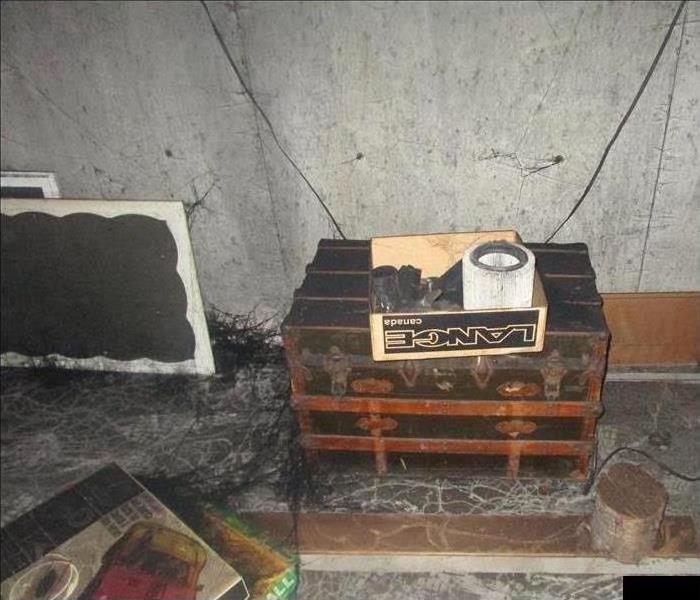 Fire damage
Fire damage
When fire strikes..Fight back!
A catastrophic event doesn't knock on your door first; Rebuilding your life AFTER A FIRE comes with uncertainty, stress and doubt about the future of your property.
Flames cause damage, ash, soot and smoke residue.
There are many types of smoke.
Wet Smoke - Plastics and Rubbers Low heat, smoldering, pungent odor, sticky, smeary. Smoke webs are more difficult to clean.
Dry smoke - Paper and Wood Fast burning, high temptures, heat rises therefore the smoke rises.
Protein Fire Residue- Produced by evaporation of materials rather than from a Fire. Virtually invisible, discolors paints and varnishes, extreme pungent odor.
From a little fire to a total loss SERVPRO of Lebanon/Hanover/Littleton professionals will beable to help you in the unfortunate event that your home or business gets ravaged by fire.
The most important thing to remember AFTER A FIRE in your home or business is to contact SERVPRO of Lebanon/Hanover/Littleton 603.298.6942
#SERVPROofLebanon/Hanover/Littleton #SERVPRO603 #HereToHelp
IN CASE OF A FIRE
5/24/2018 (Permalink)
TIPS: in the case of a fire
Residents in an apartment building may face two situations. Either the fire could be in your apartment. OR the fire could be in another apartment in the building.
- CALL 9-1-1
- Make sure everyone is out and safe, including pets.
- Once you leave the fire do NOT go back in.
- Alert others in the building.
- Activate the fire alarm, if there is one.
- Close doors behind you, this will slow the spread of the fire.
- If you are in a multi-story building, do NOT use any elevators.
- If you become trapped in a room, these steps are recommended:
- Keep door closed. Opening the door will decrease your chances of survival.
- Stay low.
- Wait by the window and identify your distress.
- Do NOT hide under beds or in closets
- Seal the bottom of the door with blankets or clothing to keep the smoke out
- Exits should never be blocked.
- Have and know a fire escape plan.
Types of smoke:
- Wet Smoke- Plastics and Rubbers= Low heat, smoldering, pungent odor, sticky, smeary.
- Dry Smoke- Paper and Wood= Fast burning, high temperatures,
- Protein Fire Residue- Produced by evaporation of materials rather than from a fire. Discolors paints and varnishes, extreme pungent odor.
How should a fire damage be cleaned up? Call SERVPRO!
If a house sustains a fire, it is important that you get the proper clean up so the soot, ash and water do not wreak havoc on what is left. It is bad enough there was a fire, but the water and chemicals used to put the fire out can cause secondary damage.
The average person will attempt conventional cleaning methods like renting a steam cleaner and using common cleaning agents from the store. This could cause more damage, as the chemical agents could react with the residue and cause more or even permanent damage and also toxic fumes.
Our crews are IICRC certified to handle these types of clean ups.
#SERVPROofLebanon/Hanover/Littleton #SERVPRO603 #HereToHelp
Call SERVPRO Lebanon/Hanover/Littleton at 603-298-6942 with any questions. We are available 24 hours a day!
PUFF BACK!
3/27/2018 (Permalink)
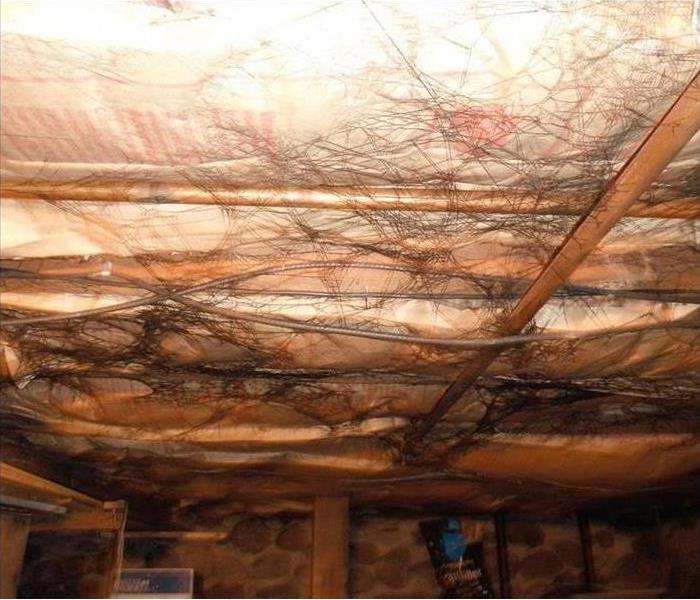 Soot Webs
Soot Webs
Puff Back!
Puff backs are explosions that occur when oil-burning furnaces don't ignite properly due to system oil leaks, clogs or other problems. If a furnace connects to a forced-air system, the soot and smoke from a puff back is distributed through the duct system to every room it serves. It contaminates the air and leaves a grimy, sticky residue on virtually every exposed surface. A puff back creates an overwhelming mess, and if it's not cleaned promptly and properly, it can cause permanent damage to a home's contents and serious health problems for those who live there.
It's almost impossible for a non-professional to fully restore the environment after a puff back. Most common cleaning methods and products are ineffective, and those who try to use them may find that they only make things worse. For example, vacuuming drives soot deeper into carpeting and upholstery, and this often causes permanent stains. Without professional cleaning and restoration, residual soot can cause corrosion on metal fixtures and even electronic devices throughout the home.
Without the proper equipment and personal protection devices, exposure to the tiny, oil-based particles can result in a variety of potential respiratory illnesses, skin or eye irritation, nausea, vomiting and dizziness. Long-term exposure caused by inadequate cleaning after a puff back may result in an increased risk of cancer and cardiovascular problems.
Fortunately, cleaning companies that specialize in smoke and fire restoration, such as SERVPRO of Lebanon/Hanover/Littleton have the IICRC training, knowledge and expertise to handle puff back clean-ups in a safe and effective way. Professional cleaning guards homeowners against exposure to toxic substances and restores their home's contents without causing further damage. Hiring a professional cleaning company such as SERVPRO of Lebanon/Hanover/Littleton also reduces liability if a puff back occurs in a commercial building. Whether a puff back disaster affects a home or a business, professional intervention reduces loss and ensures the best possible outcome.
To learn more about our fire damage clean-up process click here.
#SERVPROofLebanon/Hanover/Littleton #SERVPRO603 #HereToHelp
Fires Happen, Even in the Colder Weather
2/5/2018 (Permalink)
Fires don’t just happen in hot weather. They can happen anytime, even in the winter months. The first 24-48 hours can make all the difference between restoring and replacing. Responding quickly, with the right tools and equipment, we can get your business back up and running or back into your home as quickly as possible.
Here are 5 of the most common Fire causes in the winter months:
- Candles- Keep candles away from flammable objects. Careless candle placement is the leading cause of fires in the US.
- Space Heaters- Just like candles, space heater fires are common. Most due to clothing, curtains, or other flammable objects placed too close to the heaters. Need to keep flammable objects AT LEAST 3 feet from heaters.
- Fire Places- Always make sure to put out the fire before you leave your home or go to bed at night. Always keep a watchful eye while gas or logs are burning.
- Over-worked Electrical Outlets- Heating appliances require a large amount of electricity. You should only have 1 heating appliance plugged in to an electrical outlet at a time.
- NON Working Smoke Detectors- Smoke detectors are your biggest and fastest help in a fire! Be sure to check your smoke detectors. They need to be fully functioning and have fresh batteries for winter months. Batteries should be changed at least TWICE a year. Daylight savings time is a good way to remember to change your batteries. However, your smoke detectors should be tested once a month, and replaced every 7-10 years.
What to do in the case of a fire:
- Try not to panic
- Tell everyone in the house
- Have a pre-planned exit plan, use it as safely and as quickly as possible
- Smoke rises, so stay low or crawl. The air is cleaner and will be easier to breathe
- Do not try to gather possessions or valuables
- If it is possible, close the door to where the fire is, and close each door as you leave the room. This will help slow the spread of the fire.
- Be careful when you have to open a door, tap quickly or touch with the back of your hand. If the knob is hot, DO NOT OPEN IT, good chance fire is on the other side
- Do not go back into the building
- Find a safe place near the building and wait for help to arrive
- Do NOT go back in to the building
6 Things you need to do after a fire:
- Call your insurance company immediately
- Ask about restoration companies, like SERVPRO, that can help with the cleaning, boarding windows and other construction.
- When it is safe to re-enter your home, separate damaged items from undamaged
- Save undamaged property and items from further destruction.
- Cooperate FULLY with the insurance companies investigation
- Find somewhere to stay if you cannot stay in your home safely
If you should fall victim to the unfortunate event of a fire call SERVPRO of Lebanon/Hanover/Littleton at 603.298.6942
To learn more about our fire clean up services Click Here
#SERVPROofLebanon/Hanover/Littleton #SERVPRO603 #HereToHelp
HOLIDAY FIRE SAFTEY!
12/11/2017 (Permalink)
Although the weather is colder, fires in the home are still a huge risk.
Its Christmas time, people are putting up decorations, lights, and Christmas trees.
Christmas trees cause approximately 200 home fires per year, which result in approximately 6 deaths, 16 injuries, and around $14.8 million in property damage.
Christmas decorations have caused approximately 840 home structural fires, 3which have resulted in about 2 deaths, 36 injuries and $11.4 million in damage.
This doesn’t mean don’t decorate your home for the holidays, it just means, please be careful, and use the necessary precautions!
When decorating your home and tree this holiday season, here are some tips to keep in mind:
- Examine all of your cords. Make sure there are no tears, and that all the prongs are intact.
- Do not overload extension cords, and if plugs call for 3 prong, get a 3 prong extension cord.
- Choose a tree with fresh, green, needles that do not fall off when touched.
- Place the tree at least 3ft away from any heat source, (EX: fireplace, radiators, heat vents, candles or lamps.)
- Do not block exits with tree.
- Make sure with a real tree you are watering it daily.
- When decorating, replace any bad cords or lights that are damaged.
- Make sure to turn off lights when leaving the home or going to bed.
- After Christmas, dispose of the tree properly.
We at SERVPRO, hope you have a Safe and Happy Holiday!
If you should fall victim to the unfortunate event of a fire call SERVPRO of Lebanon/Hanover/Littleton at 603.298.6942
To learn more about Fire Damage Clean-up click here.
COOK SAFELY!
11/13/2017 (Permalink)
Have a Safe and Happy Thanksgiving
Each November, families gather to celebrate Thanksgiving by preparing a delicious feast, but if you don't practice safe cooking habits, your happy holiday could become hazardous very quickly. According to the National Fire Protection Association, cooking is the main cause for home fires and injuries, with Thanksgiving being the peak day for cooking related fires. Review the following safety tips to help ensure you enjoy a safe holiday.
COOK SAFELY!
- Do not wear loose clothing while cooking
- Never leave cooking food unattended
- Use a timer as a reminder that the stove or oven is on
- Keep flammable items such as pot holders, towels, food packaging; away from appliances and flame
- Clean cooking surfaces on a regular basis to prevent grease build up
- Keep a fire extinguisher, rated for all types of fire, in a handy location
If a Fire should occur in your home, call the Clean up Team at 603.298.6942
FIRE SAFTEY!
10/18/2017 (Permalink)
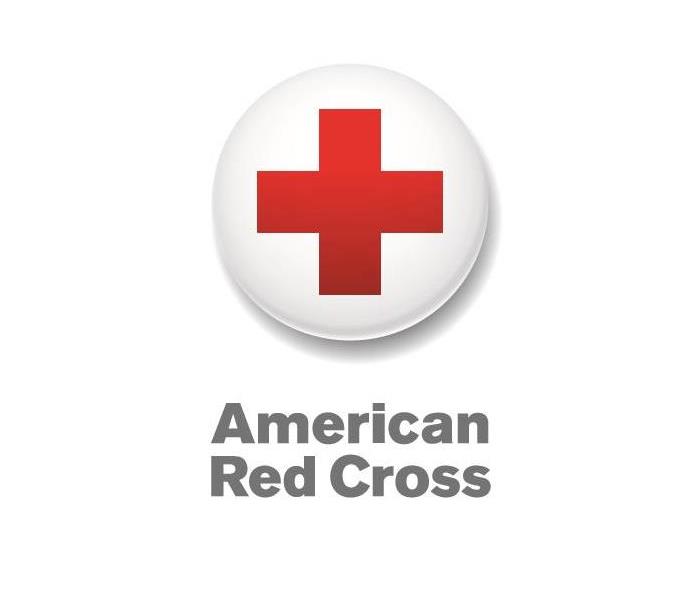 Red Cross
Red Cross
What to do in a fire…..
House Fires
- Call 911
- If you suspect a fire, make sure everyone is out and safe, including pets.
- Once out of the residence, stay out.
- If you become trapped in a room, these steps are recommended:
- Keep door closed. Opening the door will decrease your chance of survival.
- Stay low to the floor. Smoke rises and fresher air remains lower to the ground.
- Wait by the window and identify your distress.
- Don’t hide under beds or in closets.
- Seal the bottom of the door with blankets or clothing to keep smoke out.
Apartment Fires
- Residents may face two situations. The first is a fire in the apartment you live in. Second is a fire in someone else’s apartment. In either case, it is best to have a plan and know precisely how to respond.
- If there is a fire in your apartment, it is important to slow the fire spread by closing the doors behind you, so other people will have time to evacuate the building.
- Call 911 immediately, and then alert others in the building of the fire.
- Activate the fire alarm if there is one.
- Identify two exits out of your apartment, and make them known to other family members.
Multi-Story Building Fires
- Do not use elevator.
- Find evacuation signs in the stairwell landing that will give you information.
- Fire doors in the halls should never be blocked for any reason.
American Red Cross Home Fire Campaign Video
#SERVPROofLebanon/Hanover/Littleton #SERVPRO603 #HereToHelp #AmericanRedCross
FIGHT FIRE THIS FALL
10/11/2017 (Permalink)
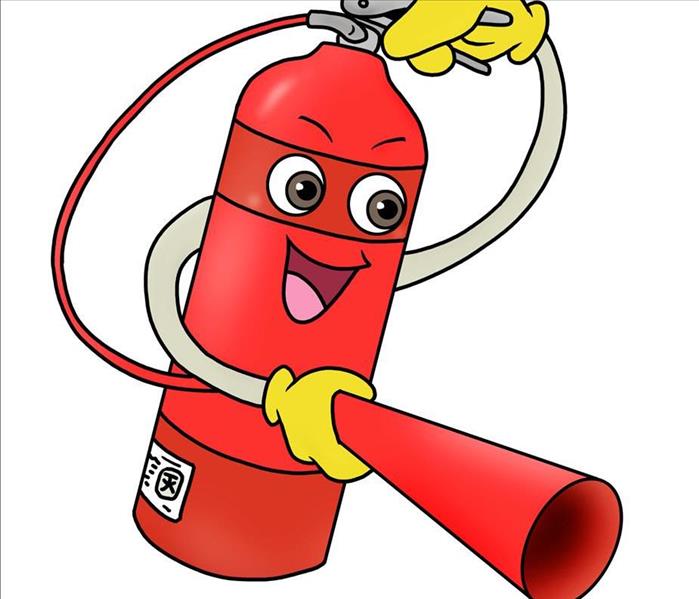 Fire Extinguisher
Fire Extinguisher
Fight fire Safely
A fire extinguisher can be a life saving tool when used correctly. The U.S. Fire Administration (USFA) recommends individuals are properly trained in order to use and maintain an extinguisher. USFA says an extinguisher should only be used if:
- You have alerted other occupants and someone has called the fire department;
- The fire is small and contained to a single object, such as a wastebasket;
- You are safe from toxic smoke produced by the fire;
- You have a means of escape identified and the fire is not between you and the escape route; and
- Your instincts tell you that is is safe to use an extinguisher.
Choosing the Proper Fire Extinguisher for Your Needs
Class A: For use with fires involving ordinary combustible materials such as cloth, wood, rubber, paper, and many plastics.
Class B: Used on fires involving flammable liquids, such as grease, gasoline and oil.
Class C: Suitable for use on fires involving appliances, tools or other equipment that is electrically energized or plugged in.
Class D: For use on flammable metals and are often specific for the type of metal in question. These are typically found only in factories working with these metals.
Class K: For use on fires involving vegetable oils, animal oils, or fats in cooking appliances. These extinguishers are generally found in commercial kitchens, but are becoming more popular in the residential market.
Watch a short fire video here
For more information call us at 603.298.6942 or email us at miperez@nhvt.net
#SERVPROofLebanon/Hanover/Littleton #SERVPRO603 #HereToHelp
SERVICE RESPONSE GUIDELINES
8/7/2017 (Permalink)
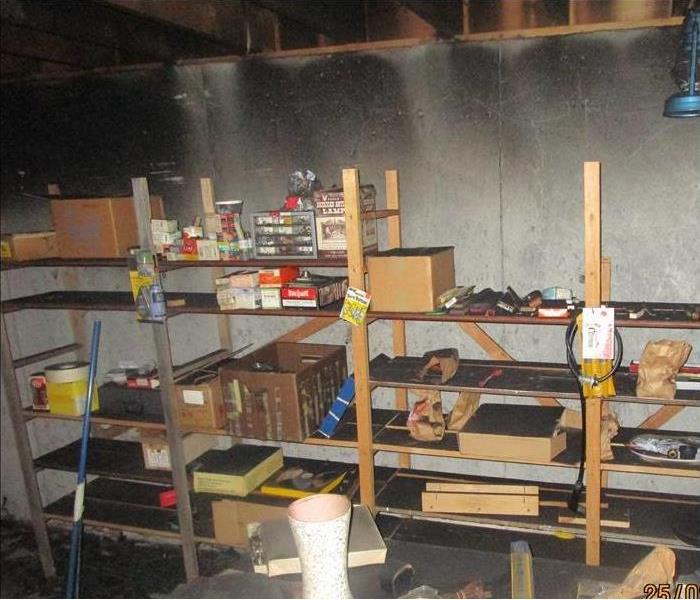 Soot Damage
Soot Damage
Working to make fire damage,"Like it never even happened."
Fire damage in a business can be stressful for owners, property managers, employees and tenants. Property damage, equipment damage, document loss and temporary business closure are just some of the concerns you may experience. Timely response and thorough mitigation can alleviate these concerns.
The first 24 hours can make the difference between restoring versus replacing your business property and belongings. SERVPRO of Lebanon/Hanover/Littleton 1-4-8 Service Response Guidelines can prevent fire damage from creating long term problems.
1 - Within 1 hour from notice of loss, a SERVPRO of Lebanon/Hanover/Littleton Professional contacts you to arrange for services.
4 - Within 4 hours of loss notification, a SERVPRO of Lebanon/Hanover/Littleton professional is on-site to start mitigation services.
8 - Within 8 business hours of on-site arrival, a verbal briefing of the scope is communicated to the appropriate person.
**Exceptions may apply under certain conditions, such as a local catastrophic event or storm situation.
Have Questions about Fire, Smoke, or Soot Damage?
Call Us Today - (603) 298-6942
#SERVPROofLebanon/Hanover/Littleton #SERVPRO603 #HereToHelp
What to do when a fire strikes!
6/8/2017 (Permalink)
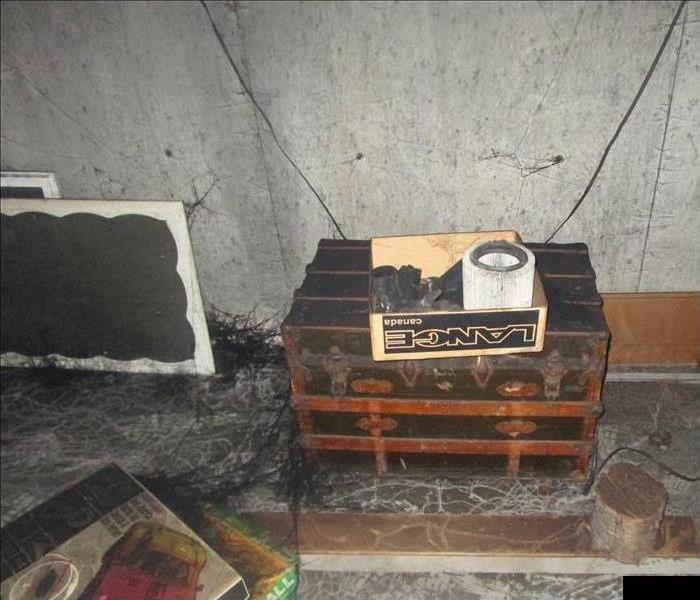 #SERVPROofLebanon/Hanover/Littleton #SERVPRO603 #HereToHelp
#SERVPROofLebanon/Hanover/Littleton #SERVPRO603 #HereToHelp
When fire strikes..Fight back!
A catastrophic event doesn't knock on your door first; Rebuilding your life AFTER A FIRE comes with uncertainty, stress and doubt about the future of your property.
Flames cause damage, ash, soot and smoke residue.
There are many types of smoke.
Wet Smoke - Plastics and Rubbers Low heat, smoldering, pungent odor, sticky, smeary. Smoke webs are more difficult to clean.
Dry smoke - Paper and Wood Fast burning, high temptures, heat rises therefore the smoke rises.
Protein Fire Residue- Produced by evaporation of materials rather than from a Fire. Virtually invisible, discolors paints and varnishes, extreme pungent odor.
From a little fire to a total loss SERVPRO of Lebanon/Hanover/Littleton professionals will beable to help you in the unfortunate event that your home or business gets ravaged by fire.
The most important thing to remember AFTER A FIRE in your home or business is to contact SERVPRO of Lebanon/Hanover/littleton 603.298.6942
#SERVPROofLebanon/Hanover/Littleton #SERVPRO603 #HereToHelp
SUMMER SAFTEY TIPS!
6/5/2017 (Permalink)
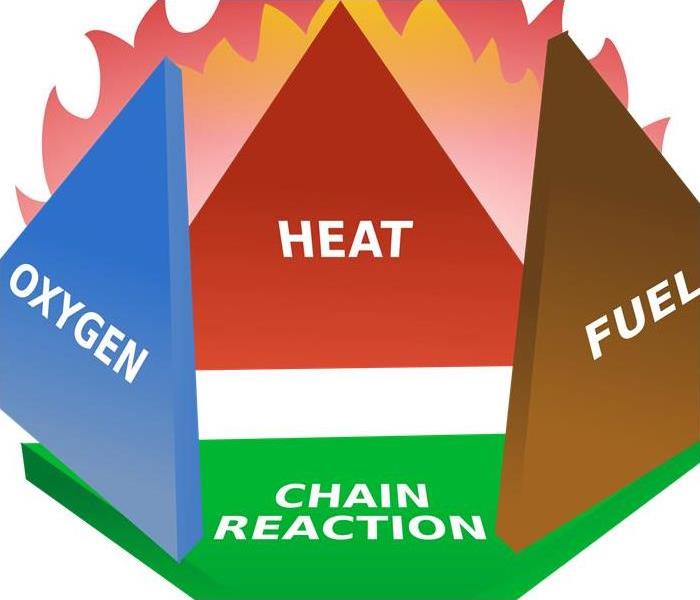 #SERVPROofLebanon/Hanover/Littleton #SERVPRO603 #HereToHelp
#SERVPROofLebanon/Hanover/Littleton #SERVPRO603 #HereToHelp
Celebrate Summer Safely!
The summer season should be a time to make memories and enjoy the great outdoors.
The following tips, provided by the National Fire Protection Association, will help keep you safe all summer long.
•When using a charcoal grill, ONLY USE starter fluids designed for the barbecue grills: DO NOT add fluid after coals have been lit.
•When using a gas grill, ensure the hose connections are tight; check hoses for leaks. Applying soapy water to the hoses will easily and safely revel any leaks.
•Always wear a U.S. Coast Guard-approved PFD (personal flotation device) when boating, jet-skiing, tubing or water skiing. Air-filled swimming aids, like water wings or inner tubes, are not substitutes for approved PFDs. An adult should always supervise children using these devices.
•Be sure to extinguish all smoking materials and shut down motors and heating devices before fueling a boat. In case of a spill, wipe up fuel and check for fuel leakage and odors.
•When camping, always use a flame retardant tent and set up camp far away from the campfire. Only use flashlights or battery-powered lanterns inside the tent, not liquid-filled heaters or lanterns.
•Always build a campfire down wind from the tent area. Clear vegetation and dig a pit before building your campfire. Always extinguish the fire before going to sleep or leaving the campsite. To extinguish, pour water over the fire, and/or cover with dirt.
•Store liquid fire starter (not gasoline) away from your tent and campfire, and only use dry kindling to freshen a campfire.
•Consider leaving firework use to a trained professional. Stay back at least 500 feet from professional fireworks displays.
If you should fall victim to the unfortunate event of a fire call SERVPRO of Lebanon/Hanover/Littleton at 603.298.6942
To learn more about our fire damage clean-up process click here
#SERVPROofLebanon/Hanover/Littleton #SERVPRO603 #HereToHelp
WHEN DO YOU NEED FIRE RESTORATION SERVICES?
1/24/2017 (Permalink)
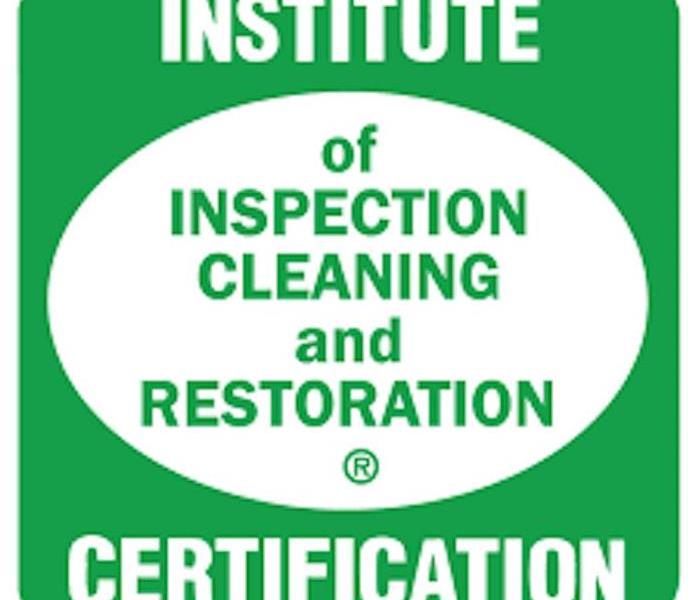 IICRC
IICRC
How Should Fire Damage Cleanup Be Handled
If a house sustains fire damage, proper cleanup is crucial as the ash, soot and water will wreak havoc on what remains. It’s bad enough there was a fire, but the water and chemicals used to extinguish it can cause secondary damage. The remnants will continue to do damage long after the flames are extinguished.
The average person will attempt conventional cleaning methods like renting a steam cleaner and using common cleaning agents available at the store. Unfortunately, this will barely make an impact on the problem and could cause bigger issues. Chemical agents could react with the residue and cause permanent damage, and in some cases, they may cause toxic fumes. Fire damage cleanup is one of the most difficult jobs out there, and it should be left to a professional for the best results.
When selecting a firm that does the restoration, consider what type of training they have. Do they have health and safety certifications? Are they experienced in a wide range of repair? Do they have proof of proper insurance and licenses? The company that has the Institute of Inspection, Cleaning and Restoration Certification (IICRC) fire and smoke restoration Certified Firm meets all of these expectations and conditions. An IICRC-certified firm understands the need for a quick response. Immediate action is necessary because the longer the delay, the harder and more costly the job will be as reactions within the damaged material can continue to occur. The fire may be gone, but the ash, soot and smoke odors that remain can continue to do harm. Certified firms will use their knowledge of fire restoration to accurately test the damage and apply the proper repair techniques to bring the items back to pre-loss condition when possible.
Also, when hiring an IICRC certified firm you can be sure that they are up to date with the latest technologies and techniques. In order for these firms to keep their certification, they are required to take continuing education programs. So when confronted with fire damage cleanup, choose an IICRC-certified professional.
To learn more about our fire damage clean-up process click here
#SERVPROofLebanon/Hanover/Littleton #SERVPRO603 #HereToHelp
TOP 2 HOME FIRE HAZARDS.
10/31/2016 (Permalink)
It's house fire season: Here are the top 2 most common fire hazards in the home.
The National Fire Protection Association (NFPA) says there are more than 360,000 home structure fires each year, resulting in about $6-8 billion dollars in damage.
1. Candles
Safety tips:
- Never leave a candle burning near flammable items.
- Never leave a candle burning in a child’s room or an unoccupied room.
- Make sure candles fit securing into candle holders so they won’t tip over.
- Blow out any candles before leaving a room or going to sleep.
2. Smoking
Safety tips:
- If you smoke, consider smoking outside.
- Use wide, sturdy ashtrays to catch butts and ashes.
- Look for cigarette butts under furniture and between seat cushions to make sure no lit butts have fallen someplace where they can’t be seen.
- Don’t smoke in bed, when you’re tired or around medical oxygen.
To learn more about our fire damage clean-up process click here
#SERVPROofLebanon/Hanover/Littleton #SERVPRO603 #HereToHelp






 24/7 Emergency Service
24/7 Emergency Service

















